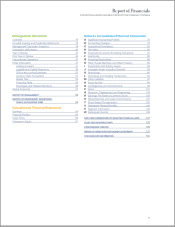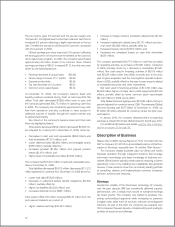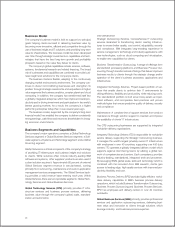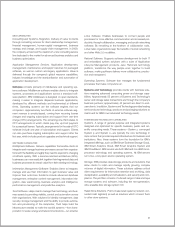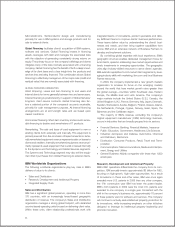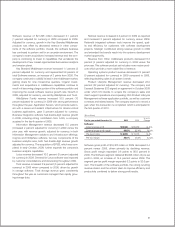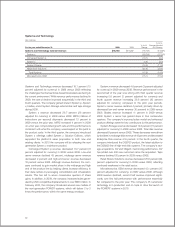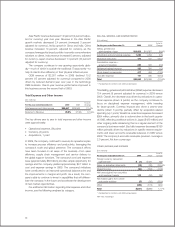IBM 2009 Annual Report Download - page 25
Download and view the complete annual report
Please find page 25 of the 2009 IBM annual report below. You can navigate through the pages in the report by either clicking on the pages listed below, or by using the keyword search tool below to find specific information within the annual report.
GBS CAPABILITIES
Consulting and Systems Integration. Delivery of value to clients
through consulting services for client-relationship management,
financial management, human-capital management, business
strategy and change, and supply-chain management. In 2009,
the company announced the creation of a new consulting service
line dedicated to the market for advanced business analytics and
business optimization.
Application Management Services. Application development,
management, maintenance and support services for packaged
software, as well as custom and legacy applications. Value is
delivered through the company’s global resource capabilities,
industry knowledge and the standardization and automation of
application development.
Software consists primarily of middleware and operating sys-
tems software. Middleware software enables clients to integrate
systems, processes and applications across a standard soft-
ware platform. IBM middleware is designed on open standards,
making it easier to integrate disparate business applications,
developed by different methods and implemented at different
times. Operating systems are the software engines that run
computers. Approximately two-thirds of external software seg-
ment revenue is annuity-based, coming from recurring license
charges and ongoing subscription and support from one-time
charge (OTC) arrangements. The remaining one-third relates to
OTC arrangements in which clients pay one, up-front payment
for a perpetual license. Typically, arrangements for the sale of OTC
software include one year of subscription and support. Clients
can also purchase ongoing subscription and support after the
first year, which includes product upgrades and technical support.
SOFTWARE CAPABILITIES
WebSphere Software. Delivers capabilities that enable clients to
integrate and manage business processes across their organiza-
tions with the flexibility and agility they need to respond to changing
conditions quickly. With a services-oriented architecture (SOA),
businesses can more easily link together their fragmented data and
business processes to extract value from their existing technology.
Information Management Software. Enables clients to integrate,
manage and use their information to gain business value and
improve their outcomes. Solutions include advanced database
management, enterprise content management, information inte-
gration, data warehousing, business analytics and intelligence,
performance management and predictive analytics.
Tivoli Software. Helps clients manage their technology and busi-
ness assets by providing visibility, control and automation across
their organizations. With solutions for identity management, data
security, storage management and the ability to provide automa-
tion and provisioning of the datacenter, Tivoli helps build the
infrastructure needed to make the world’s systems—from trans-
portation to water, energy and telecommunications—run smarter.
Lotus Software. Enables businesses to connect people and
processes for more effective communication and increased pro-
ductivity through collaboration, messaging and social networking
software. By remaining at the forefront of collaboration tools,
Lotus helps organizations reap the benefits of social networking
and other Web 2.0 modalities.
Rational Software. Supports software development for both IT
and embedded system solutions with a suite of Application
Lifecycle Management products. Jazz, Rational’s technology
platform, transforms the way people work together to build
software, making software delivery more collaborative, produc-
tive and transparent.
Operating Systems. Software that manages the fundamental
processes that make computers run.
Systems and Technology provides clients with business solu-
tions requiring advanced computing power and storage capa-
bilities. Approximately 55 percent of Systems and Technology’s
server and storage sales transactions are through the company’s
business partners; approximately 45 percent are direct to end-
user clients. In addition, Systems and Technology provides leading
semiconductor technology, products and pack aging solutions to
clients and for IBM’s own advanced tech nology needs.
SYSTEMS AND TECHNOLOGY CAPABILITIES
Systems. A range of general purpose and integrated systems
designed and optimized for specific business, public and sci-
entific computing needs. These systems—System z, converged
System p and System x—are typically the core technology in
data centers that provide required infrastructure for business and
institutions. Also, these systems form the foundation for IBM’s
integrated offerings, such as IBM Smart Business Storage Cloud,
IBM Smart Analytics Cloud, IBM Smart Analytics System and
IBM CloudBurst. IBM servers use both IBM and non-IBM micro-
processor technology and operating systems. All IBM servers
run Linux, a key open-source operating system.
Storage. IBM provides data storage products and solutions that
allow clients to retain and manage rapidly growing, complex
volumes of digital information. These solutions address critical
client requirements for information retention and archiving, data
deduplication, availability and virtualization, and security and com-
pliance. The portfolio consists of a broad range of disk and tape
storage systems and software, including the next-generation,
ultra-scalable disk storage system XIV.
Retail Store Solutions. Point-of-sale retail systems (network con-
nected cash registers) as well as solutions which connect them
to other store systems.
23






